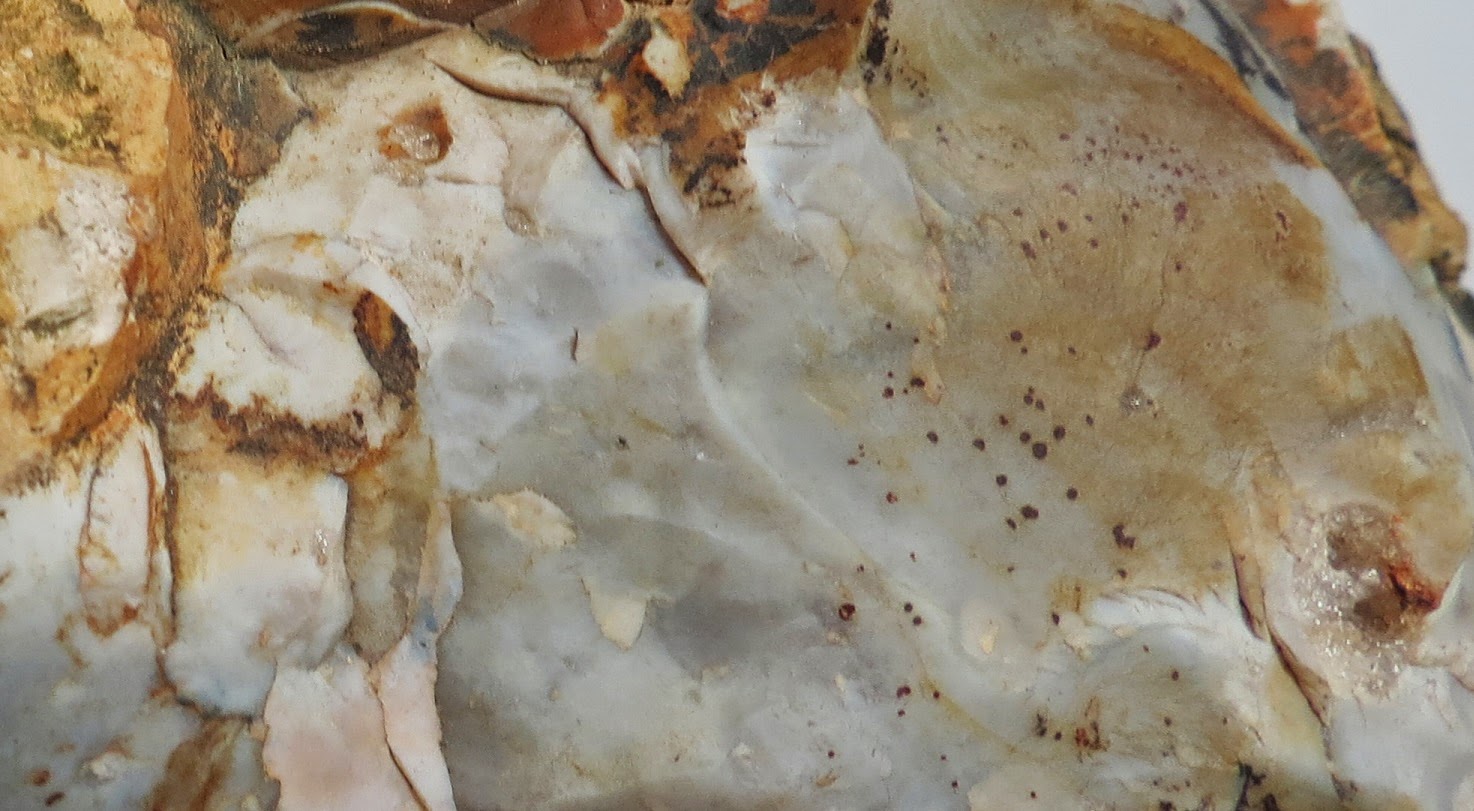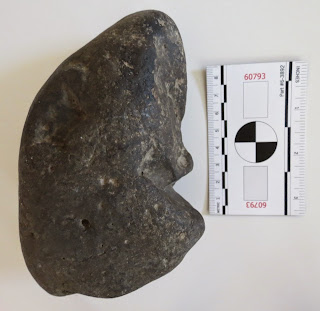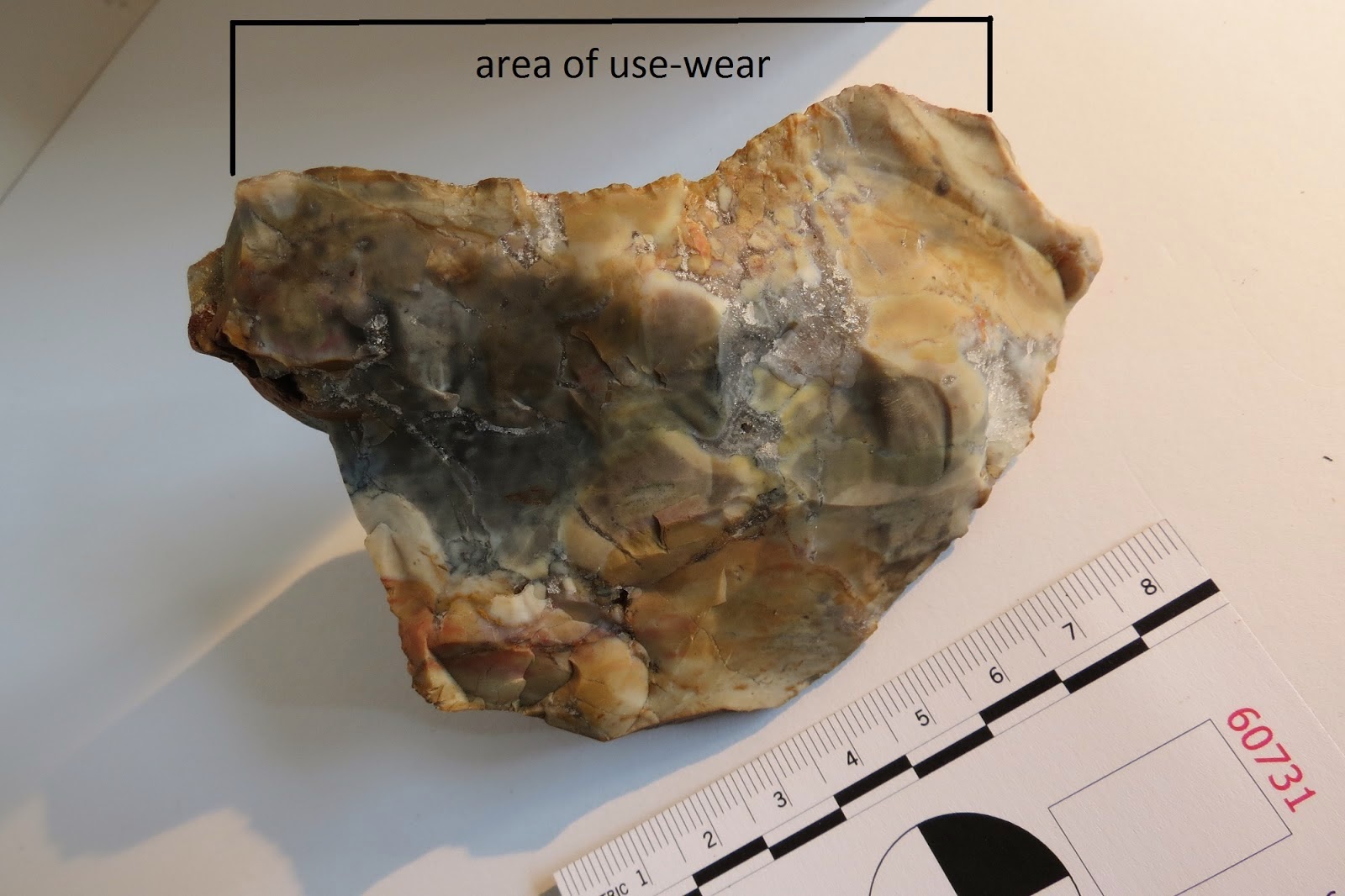Ken Johnston find, Licking County, Ohio, 10 x14 cm.
Note the human face profile facing skyward (chin at upper left of stone in this view).
For this interpretation I am indebted to fellow amateur archaeologist Denis Argaut who has already discovered and described these kinds of sound producing rocking horse sculptures in France and shared them with me and readers of this blog. Without his work and correspondence I could not make this interpretation. Thank you Denis.
The Ohio sculpture may be regarded as recording the sound of a galloping horse by way of engineering of the bottom of the stone and points where it comes into contact with a surface. It is directly comparable to acoustic portable rock art sculptural material identified by Argaut in France. When the correct "play back instructions" are known, that is, when the interpreter knows how to manipulate the sculpture in the correct fashion required using the right spot on the stone, an accurate reproduction of a horse's galloping gait may be heard.
When the sculpture is stood upright on its base it is balanced like a punching clown. It can be pushed or bumped from one side and it won't fall over and then comes back to its resting position. In this process, the base of the sculpture produces a knocking sound on a flat wood or stone surface. When paying attention to how I bumped the mammoth figure I was able to make short galloping horse sounds a few times.
Upon examination I located a heavily polished spot on the stone which seemed likely to correspond to prior repeated contact with the sculpture. I positioned the stone to present the polished spot for my thumb to push and I am able to make the galloping horse sound very nicely. I will certainly need more practice to be able to reproduce the galloping sounds as well as Denis Argaut has done but he has many hours of practice on several sound producing sculptures from France.
I searched for a suspected horse image for quite some but was not able to find one. I was expecting one bigger than the one I eventually noticed. While looking at my thumb on the stone, I noticed a small horse head figure rocking back and forth as I pushed the mammoth. The horse head figure is also the eye of the mammoth of the sculpture. The polished area which one pushes on to make the galloping sound is on the back of the horse figure. The horse head itself exploits a very small inclusion of a quartz crystal for its eye which sparkles in directed light.
It is known that elephants are able to detect thunderstorms and movements of migrating herd animals many miles away from the sound vibrations they make. It is possible the horse, the galloping sound, the mammoth and the two human facial profiles, one with a crystal pocket for an ear, are somehow related to this natural phenomenon.
Side 1
Side 2
Side 1 up close with illustrations
Side 1 up close with horse leg and thigh represented in full forward, energy-loaded, position highlighted. (PUSH HERE) indicates the polished area which is worn smooth by prehistoric handling of the stone.
Horse head and body and polished area above the horse's back
Subtle left and right human head profiles are incorporated into the mammoth/horse sculpture. (click photos to expand).
Pocket of quartz crystals in the flint on the bottom center of the sculpture was likely a motivating factor in the selection of this raw material for a greater symbolic expression. Does the crystal formation resemble a human ear? Was this ear noticed in the stone age and did it inspire the artist to include mammoth imagery in the stone in recognition of the animal's hearing prowess? Did it inspire the artist to make an acoustic sculpture which makes the sound of a galloping horse? Yes, yes and yes.
A human face mask on the sculpture is in the known Palaeoart motif of "right eye open, left eye missing" as described by others and seen in many examples to date on this blog. This mask, when considered with all the other iconic features of this stone, helps confirm its human manufacture. This is a Lower and Middle Paleolithic art motif and its existence in North America needs to be explained by archaeological science.
Video of Ohio mammoth sculpture featuring a horse image and making a galloping sound when manipulated (Ken Johnston interpretation)
The horse head is seen right above the Play> button and my thumb is placed on the polished spot which is on the horse's back. The sculpture is placed on a sheet of paper on top of a marble table with a backdrop. When manipulating the sculpture to make the galloping sound, it moves forward on a secure surface. With the paper underneath, it scoots the paper and backdrop board back, demonstrating how each push back will move the horse forward one step. It looks like the camera is pulling back but it is the paper moving back under the movement of the sculpture.
Video of France mammoth sculpture featuring a horse image and making a galloping sound when manipulated (Denis Argaut interpretation)
The horse head is seen just to the left of the Play> button above. This sculpted rock was discovered by Denis Argaut of France. Denis has identified a horse head figuration seen in the upper left part of the stone. Ken Johnston earlier interpreted the overall shape of the stone to be symbolic of a mammoth body in right profile. Play the video as Denis demonstrates how the sculpture produces a galloping horse sound like the Ohio example.
Here is a view of the horse head Denis located on the posterior of the France mammoth sculpture which produces a galloping horse sound when manipulated.
"Hello Ken, You have made a very good job ! May be the head of the horse find précisions with the SHADOWS...Have you tried to catch the slowly sound of this horse ?... Greatfull ! Denis"
Human facial profile seen on the Ohio sculpture in beautiful Flint Ridge material, Vanport formation chert.











































.JPG)







